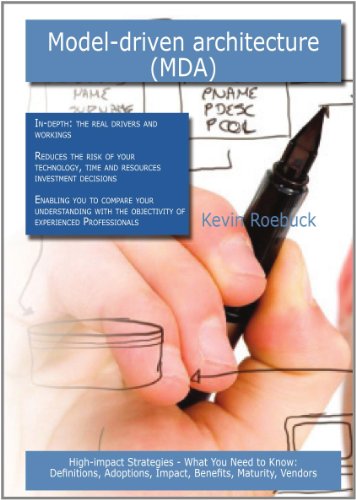MDA Distilled
暫譯: MDA 精華解析
Stephen J. MELLOR, Kendall Scott, Axel Uhl, Dirk Weise
- 出版商: Addison Wesley
- 出版日期: 2004-03-13
- 售價: $1,500
- 貴賓價: 9.8 折 $1,470
- 語言: 英文
- 頁數: 176
- 裝訂: Paperback
- ISBN: 0201788918
- ISBN-13: 9780201788914
-
相關分類:
UML
立即出貨(限量) (庫存=1)
買這商品的人也買了...
-
 Building Web Applications with UML
Building Web Applications with UML$1,420$1,349 -
 計算機組織與設計--軟硬體界面第二版 (Computer Organization & Design, 2/e)
計算機組織與設計--軟硬體界面第二版 (Computer Organization & Design, 2/e)$680$578 -
 ASP.NET 實例導引 (ASP.NET by Example)
ASP.NET 實例導引 (ASP.NET by Example)$480$408 -
 LPI Linux 資格檢定 (LPI Linux Certification in a Nutshell)
LPI Linux 資格檢定 (LPI Linux Certification in a Nutshell)$880$695 -
 Building Web Applications with UML, 2/e
Building Web Applications with UML, 2/e$1,890$1,796 -
 C++ Builder 6 完全攻略
C++ Builder 6 完全攻略$690$587 -
 ASP.NET 程式設計徹底研究
ASP.NET 程式設計徹底研究$590$466 -
 數位邏輯設計 (Digital Design, 3/e)
數位邏輯設計 (Digital Design, 3/e)$580$568 -
 數位影像處理 (Digital Image Processing, 2/e)
數位影像處理 (Digital Image Processing, 2/e)$820$804 -
 鳥哥的 Linux 私房菜-伺服器架設篇
鳥哥的 Linux 私房菜-伺服器架設篇$750$638 -
 以 Rational Rose 2002 精通 UML (Mastering UML with Rational Rose 2002)
以 Rational Rose 2002 精通 UML (Mastering UML with Rational Rose 2002)$700$630 -
 鳥哥的 Linux 私房菜─基礎學習篇增訂版
鳥哥的 Linux 私房菜─基礎學習篇增訂版$560$476 -
 CCNA Cisco Certified Network Associate Study Guide, 4/e (640-801)
CCNA Cisco Certified Network Associate Study Guide, 4/e (640-801)$1,790$1,701 -
 Hacking: The Art of Exploitation
Hacking: The Art of Exploitation$1,460$1,387 -
 Web 配色事典﹝活用網頁安全色﹞
Web 配色事典﹝活用網頁安全色﹞$390$304 -
 SCJP‧SCJD 專業認證指南 (Sun Certified Programmer & Developer for Java 2 #310-305 與310-027)
SCJP‧SCJD 專業認證指南 (Sun Certified Programmer & Developer for Java 2 #310-305 與310-027)$850$723 -
 人月神話:軟體專案管理之道 (20 週年紀念版)(The Mythical Man-Month: Essays on Software Engineering, Anniversary Edition, 2/e)
人月神話:軟體專案管理之道 (20 週年紀念版)(The Mythical Man-Month: Essays on Software Engineering, Anniversary Edition, 2/e)$480$379 -
 JSP 2.0 技術手冊
JSP 2.0 技術手冊$750$638 -
 建構嵌入式 Linux 系統
建構嵌入式 Linux 系統$780$616 -
 最新 JavaScript 完整語法參考辭典 第三版
最新 JavaScript 完整語法參考辭典 第三版$490$382 -
 ASP.NET 徹底研究進階技巧─高階技巧與控制項實作
ASP.NET 徹底研究進階技巧─高階技巧與控制項實作$650$507 -
 多媒體圖學基礎與 Web 3D 初級實作
多媒體圖學基礎與 Web 3D 初級實作$400$340 -
 Word 2003 實力養成暨評量解題秘笈
Word 2003 實力養成暨評量解題秘笈$150$128 -
 作業系統原理 (Silberschatz: Operating System Principles, 7/e)
作業系統原理 (Silberschatz: Operating System Principles, 7/e)$780$741 -
 Linux 核心詳解, 3/e (Understanding the Linux Kernel, 3/e)
Linux 核心詳解, 3/e (Understanding the Linux Kernel, 3/e)$1,200$948
相關主題
商品描述
Table of Contents:
List of Figures.
Foreword.
Preface.
1. Introduction.
2. MDA Terms and Concepts.
3. Building Models.
4. Building Metamodels.
5. Building Mappings.
6. Building Marking Models.
7. Building Languages.
8. Elaborating Models.
9. Building Executable Models.
10. Agile MDA.
11. Building an MDA Process.
12. Executing an MDA Process.
13. The Future of MDA.
Glossary.
Bibliography.
Index.
商品描述(中文翻譯)
目錄:
圖表清單。
前言。
序言。
本書組織。
常見問題。
致謝。
1. 介紹。
提升抽象層次。
提升重用層次。
設計時的互操作性。
模型作為資產。
2. MDA術語與概念。
模型。
元模型與平台。
模型之間的映射。
標記模型。
構建語言。
模型詳細化。
可執行模型。
敏捷MDA。
建立MDA流程。
執行MDA流程。
3. 建立模型。
為什麼要建模?
抽象、分類與概括。
主題與語言抽象。
模型投影。
模型與平台。
使用模型。
4. 建立元模型。
為什麼要有元模型?
元模型。
四層架構。
MOF:元建模的標準。
使用元模型。
5. 建立映射。
為什麼要有映射?
一個非正式的例子。
映射函數。
查詢、視圖與轉換(QVT)。
映射的場景。
合併映射以進行編織。
使用映射。
6. 建立標記模型。
為什麼要有標記?
標記與標記模型。
應用標記與標記模型。
關聯標記與模型元素。
其他標記。
標記與標記模型的實現。
標記模型的理論。
使用標記。
7. 建立語言。
為什麼要建立語言?
誰來定義語言?
語言中包含什麼?
使用MOF建立語言。
使用配置文件建立語言。
建立圖形符號。
使用您所建立的語言。
8. 詳細化模型。
為什麼要詳細化模型?
管理對生成模型的手動更改。
映射的可逆性。
整合遺留代碼。
使用詳細化。
9. 建立可執行模型。
為什麼要有可執行模型?
可執行UML。
執行模型。
翻譯模型。
模型編譯器。
使用可執行UML。
10. 敏捷MDA。
為什麼要敏捷MDA?
敏捷方法。
模型、模型、模型。
重新審視設計時的互操作性。
使用敏捷MDA。
11. 建立MDA流程。
為什麼要建立MDA流程?
如何處理問題。
繪製MDA流程圖。
識別模型。
識別元模型與標記模型。
映射鏈的長短。
約束傳播與驗證。
使用MDA流程。
12. 執行MDA流程。
形式化知識。
建立橋樑。
一個示例模型驅動流程。
迭代流程。
測試系統。
執行MDA流程。
13. MDA的未來。
為什麼不使用MDA?
標準的重要性。
建立工具鏈。
與模型作為資產合作。
超越UML。
來自未來的回顧。
術語表。
參考文獻。
索引。











